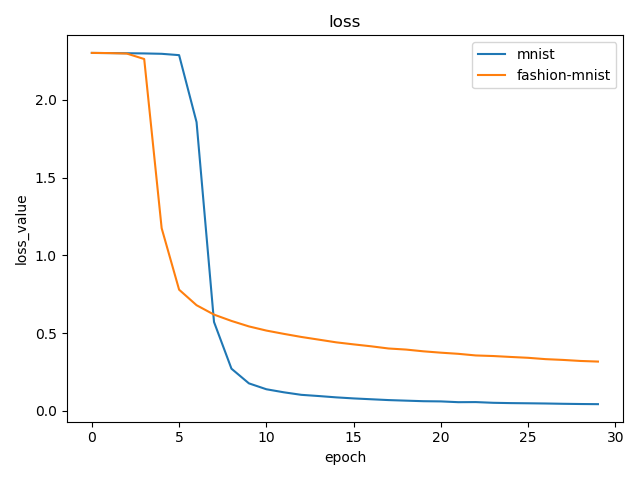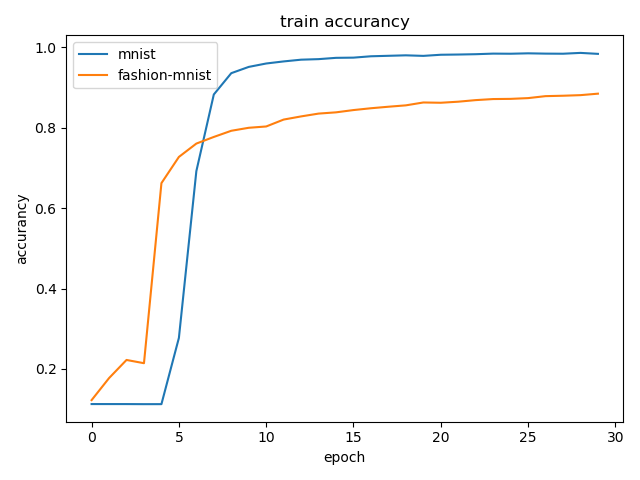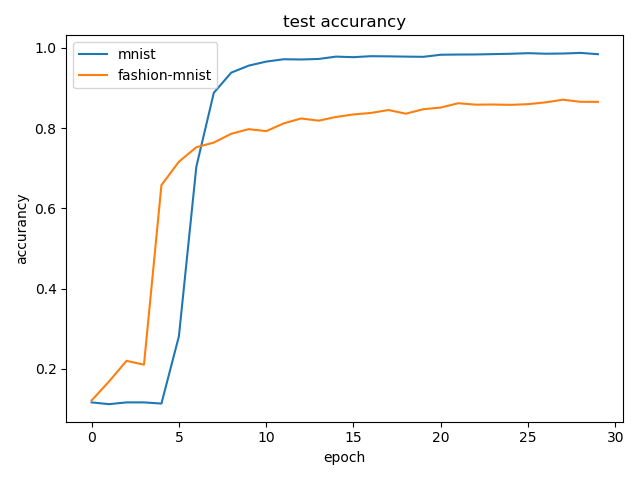1
2
3
4
5
6
7
8
9
10
11
12
13
14
15
16
17
18
19
20
21
22
23
24
25
26
27
28
29
30
31
32
33
34
35
36
37
38
39
40
41
42
43
44
45
46
47
48
49
50
51
52
53
54
55
56
57
58
59
60
61
62
63
64
65
66
67
68
69
70
71
72
73
74
75
76
77
78
79
80
81
82
83
84
85
86
87
88
89
90
91
92
93
94
95
96
97
98
99
100
101
102
103
104
105
106
107
108
109
110
111
112
113
114
115
116
117
118
119
120
121
122
123
124
125
126
127
128
129
130
131
132
133
134
135
136
137
138
139
140
141
142
143
144
145
146
147
148
149
150
151
|
"""
@author: zj
@file: mnist.py
@time: 2019-12-10
"""
import time
import torch
import torch.nn as nn
import torch.optim as optim
import torchvision.transforms as transforms
from torch.utils.data import DataLoader
import torchvision.datasets as datasets
root = './data'
bsize = 256
shuffle = True
num_work = 8
learning_rate = 1e-3
moment = 0.9
epoches = 30
classes = range(10)
def load_mnist(transform, root, bsize, shuffle, num_work):
train_dataset = datasets.MNIST(root, train=True, download=True, transform=transform)
train_loader = DataLoader(train_dataset, batch_size=bsize, shuffle=shuffle, num_workers=num_work)
test_dataset = datasets.MNIST(root, train=False, download=True, transform=transform)
test_loader = DataLoader(test_dataset, batch_size=bsize, shuffle=shuffle, num_workers=num_work)
return train_loader, test_loader
def load_fashion_mnist(transform, root, bsize, shuffle, num_work):
train_dataset = datasets.FashionMNIST(root, train=True, download=True, transform=transform)
train_loader = DataLoader(train_dataset, batch_size=bsize, shuffle=shuffle, num_workers=num_work)
test_dataset = datasets.FashionMNIST(root, train=False, download=True, transform=transform)
test_loader = DataLoader(test_dataset, batch_size=bsize, shuffle=shuffle, num_workers=num_work)
return train_loader, test_loader
def compute_accuracy(loader, net, device):
total_accu = 0.0
num = 0
for i, data in enumerate(loader, 0):
inputs, labels = data[0].to(device), data[1].to(device)
outputs = net.forward(inputs)
predicted = torch.argmax(outputs, dim=1)
total_accu += torch.mean((predicted == labels).float()).item()
num += 1
return total_accu / num
class AlexNet(nn.Module):
def __init__(self, num_channels=3, num_classes=1000):
super(AlexNet, self).__init__()
self.features = nn.Sequential(
nn.Conv2d(num_channels, 64, kernel_size=11, stride=4, padding=2),
nn.ReLU(inplace=True),
nn.MaxPool2d(kernel_size=3, stride=2),
nn.Conv2d(64, 192, kernel_size=5, padding=2),
nn.ReLU(inplace=True),
nn.MaxPool2d(kernel_size=3, stride=2),
nn.Conv2d(192, 384, kernel_size=3, padding=1),
nn.ReLU(inplace=True),
nn.Conv2d(384, 256, kernel_size=3, padding=1),
nn.ReLU(inplace=True),
nn.Conv2d(256, 256, kernel_size=3, padding=1),
nn.ReLU(inplace=True),
nn.MaxPool2d(kernel_size=3, stride=2),
)
self.avgpool = nn.AdaptiveAvgPool2d((6, 6))
self.classifier = nn.Sequential(
nn.Dropout(),
nn.Linear(256 * 6 * 6, 4096),
nn.ReLU(inplace=True),
nn.Dropout(),
nn.Linear(4096, 4096),
nn.ReLU(inplace=True),
nn.Linear(4096, num_classes),
)
def forward(self, x):
x = self.features(x)
x = self.avgpool(x)
x = torch.flatten(x, 1)
x = self.classifier(x)
return x
if __name__ == '__main__':
transform = transforms.Compose([
transforms.Resize((227, 227)),
transforms.ToTensor(),
transforms.Normalize(mean=(0.5,), std=(0.5,))
])
train_loader, test_loader = load_mnist(transform, root, bsize, shuffle, num_work)
# train_loader, test_loader = load_fashion_mnist(transform, root, bsize, shuffle, num_work)
device = torch.device("cuda:0" if torch.cuda.is_available() else "cpu")
net = AlexNet(num_channels=1, num_classes=10).to(device)
criterion = nn.CrossEntropyLoss().to(device)
optimer = optim.SGD(net.parameters(), lr=learning_rate, momentum=0.9, nesterov=True)
train_accu_list = list()
test_accu_list = list()
loss_list = list()
for epoch in range(epoches):
num = 0
total_loss = 0.0
start = time.time()
for i, data in enumerate(train_loader, 0):
inputs, labels = data[0].to(device), data[1].to(device)
optimer.zero_grad()
outputs = net(inputs)
loss = criterion(outputs, labels)
loss.backward()
optimer.step()
total_loss += loss.item()
num += 1
end = time.time()
avg_loss = total_loss / num
print('[%d] loss: %.5f, time: %.3f' % (epoch + 1, avg_loss, end - start))
loss_list.append(avg_loss)
train_accu = compute_accuracy(train_loader, net, device)
test_accu = compute_accuracy(test_loader, net, device)
print('train: %.3f, test: %.3f' % (train_accu, test_accu))
train_accu_list.append(train_accu)
test_accu_list.append(test_accu)
print(loss_list)
print(train_accu_list)
print(test_accu_list)
|
![]()


